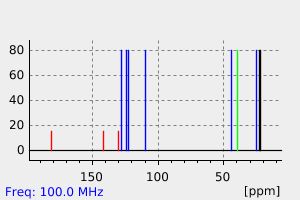3-异丁基-1,3-二氢吲哚-2-酮 | 251550-17-1
中文名称
3-异丁基-1,3-二氢吲哚-2-酮
中文别名
3-异丁基-2-羟吲哚
英文名称
3-isobutylindolin-2-one
英文别名
3-Isobutyl-2-oxindole;3-(2-methylpropyl)-1,3-dihydroindol-2-one
CAS
251550-17-1
化学式
C12H15NO
mdl
MFCD06245571
分子量
189.257
InChiKey
UHNMEXRCASTLJV-UHFFFAOYSA-N
BEILSTEIN
——
EINECS
——
-
物化性质
-
计算性质
-
ADMET
-
安全信息
-
SDS
-
制备方法与用途
-
上下游信息
-
文献信息
-
表征谱图
-
同类化合物
-
相关功能分类
-
相关结构分类
物化性质
-
熔点:96.0-97.0 °C(Solv: dichloromethane (75-09-2); hexane (110-54-3))
-
沸点:313.6±31.0 °C(Predicted)
-
密度:1.039±0.06 g/cm3(Predicted)
计算性质
-
辛醇/水分配系数(LogP):2.5
-
重原子数:14
-
可旋转键数:2
-
环数:2.0
-
sp3杂化的碳原子比例:0.416
-
拓扑面积:29.1
-
氢给体数:1
-
氢受体数:1
安全信息
-
危险品标志:Xi
-
海关编码:2933990090
SDS
上下游信息
反应信息
-
作为反应物:描述:3-异丁基-1,3-二氢吲哚-2-酮 在 N-溴代丁二酰亚胺(NBS) 、 potassium carbonate 、 三乙胺 作用下, 以 二氯甲烷 为溶剂, 反应 1.0h, 生成 methyl 3a-(3-isobutyl-2-oxoindolin-3-yl)-8-methyl-3,3a,8,8a-tetrahydropyrrolo[2,3-b]indole-1(2H)-carboxylate参考文献:名称:对映选择性[4 + 2]环加成/环化级联反应和顺式-双(环色胺)生物碱的全合成摘要:描述了通过正式的[4 + 2]环加成/环化级联反应3-环色胺取代的羟吲哚的不对称催化合成。在温和的反应条件下,以对映体富集的形式获得了广泛的环色胺衍生物,发现它们具有潜在的抗癌活性。该策略使C 3a – C 3a'位置的环色胺亚基易于组装,并具有两个四级立体异构中心,具有顺式选择性,从而可以合成光学活性的顺式双(六氢吡咯并吲哚)和环色胺生物碱家族的其他化合物。DOI:10.1021/acs.orglett.1c00260
-
作为产物:描述:(2-methylpropylidene)indolin-2-one 在 sodium tetrahydroborate 作用下, 以 乙醇 为溶剂, 生成 3-异丁基-1,3-二氢吲哚-2-酮参考文献:名称:A Facile Method for the Synthesis of 3-Alkyloxindole摘要:苯甲胺与乙酸组合被确认为一种强效催化剂,用于氧化吲哚与醛、丙酮或环酮的缩合反应。通过苯甲胺乙酸盐催化下的氧化吲哚与醛(或酮)的连续缩合反应以及随后由硼氢化钠进行的共轭还原,可以方便地在10毫摩尔规模上制备多种3-烷基氧化吲哚。DOI:10.2174/157017812800167420
文献信息
-
C-3 alkylation of oxindole with alcohols by Pt/CeO<sub>2</sub> catalyst in additive-free conditions作者:Chandan Chaudhari、S. M. A. Hakim Siddiki、Kenichi Kon、Atsuko Tomita、Yutaka Tai、Ken-ichi ShimizuDOI:10.1039/c3cy00911d日期:——In a series of transition metal-loaded CeO2 catalysts and Pt-loaded catalysts on various supports, Pt-loaded CeO2 shows the highest activity for the selective C-3 alkylation of oxindole with octanol. The catalyst is effective for alkylation of oxindole and N-substituted oxindole with a series of substituted benzyl, linear, hetero-aryl alcohols under additive-free conditions and is recyclable. Our results
-
Piperazine Derivatives of Dialkyl Oxindoles申请人:Volk Balazs公开号:US20070232619A1公开(公告)日:2007-10-04The present invention is concerned with new 3,3-disubstituted indol-2-one derivatives of the general Formula (I), wherein R 1 stands for hydrogen, halogen, alkyl having 1-7 carbon atom(s) or sulfonamido; R 2 represents hydrogen or halogen; R 3 denotes hydrogen, alkyl having 1-7 carbon atom(s) optionally carrying an aryl substituent or aryl optionally carrying one or two halogen substituent(s); R 4 stands for alkyl having 1-7 carbon atom(s); R 5 represents a group of the general Formula (II a) or (II b), wherein Q and W each represents nitrogen or CH; R 6 , R 7 and R 8 each stands for hydrogen, halogen, trifluoromethyl, alkyl or alkoxy having 1-7 carbon atom(s), or R 6 and R 7 together represent ethylenedioxy; m is 0, 1, or 2; a is a single, double or triple bond; n is 0, 1 or 2; and pharmaceutically acceptable acid addition salts thereof which are useful in the treatment or prophylaxis of diseases of the central nervous system, the gastrointestinal system and the cardiovascular system.
-
Raney Nickel-Induced 3-Alkylation of Oxindole with Alcohols and Diols作者:Balázs Volk、Tibor Mezei、Gyula SimigDOI:10.1055/s-2002-23544日期:——New reaction conditions are described, which turn Wenkert’s synthesis of 3-alkyloxindoles (Raney nickel-induced alkylation of oxindole with alcohols) into a reproducible and highly efficient synthetic tool. The method is also extended to the preparation of 3-(Ï-hydroxyalkyl)oxindoles.
-
New One-Pot Synthesis of 3-Alkyl- and 3-(ψ-Hydroxyalkyl)oxindoles from Isatins作者:Balázs Volk、Gyula SimigDOI:10.1002/ejoc.200300219日期:2003.10A new and efficient one-pot procedure has been developed for the synthesis of 3-alkyl- and 3-(ψ-hydroxyalkyl)oxindoles from isatins by treatment with alcohols and diols in the presence of Raney nickel, under hydrogen atmosphere. (© Wiley-VCH Verlag GmbH & Co. KGaA, 69451 Weinheim, Germany, 2003)
-
(Phenylpiperazinyl-butyl)oxindoles as Selective 5-HT<sub>7</sub> Receptor Antagonists作者:Balázs Volk、József Barkóczy、Endre Hegedus、Szabolcs Udvari、István Gacsályi、Tibor Mezei、Katalin Pallagi、Hajnalka Kompagne、György Lévay、András Egyed、László G. Hársing, Jr.、Michael Spedding、Gyula SimigDOI:10.1021/jm070279v日期:2008.4.1contain a 1,3-dihydro-2 H-indol-2-one (oxindole) skeleton. The binding of these compounds to the 5-HT 7 and 5-HT 1A receptors was measured. Despite the structural similarity of these two serotonin receptor subtypes, several derivatives exhibited a high selectivity to the 5-HT 7 receptor. According to the structure-activity relationship observations, compounds unsubstituted at the oxindole nitrogen atom已经合成了一系列有效的5-羟基色胺7(5-HT 7)配体,它们含有1,3-二氢-2 H-吲哚-2-酮(羟吲哚)骨架。测量了这些化合物与5-HT 7和5-HT 1A受体的结合。尽管这两种5-羟色胺受体亚型在结构上相似,但是一些衍生物对5-HT 7受体表现出高选择性。根据结构-活性关系的观察,在羟吲哚氮原子上未被取代并且在羟吲哚骨架和碱性氮原子之间包含四亚甲基间隔基的化合物是最有效的配体。关于碱性基团,除了4-苯基哌嗪类型的部分外,卤代苯基-1,2,3,6-四氢吡啶也被证明是5-HT 7受体-配体。由于芳香环上的卤素取代,可以达到良好的代谢稳定性。该家族的代表,3- 4- [4-(4-氯苯基)-哌嗪-1-基]-丁基} -3-乙基-6-氟-1,3-二氢-2 H-吲哚-2 -1(9e')表现出选择性的5-HT 7拮抗剂活性(K i = 0.79 nM)。这些5-HT 7受体-配体的体内药理作用是
表征谱图
-
氢谱1HNMR
-
质谱MS
-
碳谱13CNMR
-
红外IR
-
拉曼Raman
-
峰位数据
-
峰位匹配
-
表征信息
同类化合物
(Z)-3-[[[2,4-二甲基-3-(乙氧羰基)吡咯-5-基]亚甲基]吲哚-2--2-
(S)-(-)-5'-苄氧基苯基卡维地洛
(R)-(+)-5'-苄氧基卡维地洛
(R)-卡洛芬
(N-(Boc)-2-吲哚基)二甲基硅烷醇钠
(E)-2-氰基-3-(5-(2-辛基-7-(4-(对甲苯基)-1,2,3,3a,4,8b-六氢环戊[b]吲哚-7-基)-2H-苯并[d][1,2,3]三唑-4-基)噻吩-2-基)丙烯酸
(4aS,9bR)-6-溴-2,3,4,4a,5,9b-六氢-1H-吡啶并[4,3-B]吲哚
(3Z)-3-(1H-咪唑-5-基亚甲基)-5-甲氧基-1H-吲哚-2-酮
(3Z)-3-[[[4-(二甲基氨基)苯基]亚甲基]-1H-吲哚-2-酮
(3R)-(-)-3-(1-甲基吲哚-3-基)丁酸甲酯
(3-氯-4,5-二氢-1,2-恶唑-5-基)(1,3-二氧代-1,3-二氢-2H-异吲哚-2-基)乙酸
齐多美辛
鸭脚树叶碱
鸭脚木碱,鸡骨常山碱
鲜麦得新糖
高氯酸1,1’-二(十六烷基)-3,3,3’,3’-四甲基吲哚碳菁
马鲁司特
马鞭草(VERBENAOFFICINALIS)提取物
马来酸阿洛司琼
马来酸替加色罗
顺式-ent-他达拉非
顺式-1,3,4,4a,5,9b-六氢-2H-吡啶并[4,3-b]吲哚-2-甲酸乙酯
顺式-(+-)-3,4-二氢-8-氯-4'-甲基-4-(甲基氨基)-螺(苯并(cd)吲哚-5(1H),2'(5'H)-呋喃)-5'-酮
靛青二磺酸二钾盐
靛藍四磺酸
靛红联二甲酚
靛红磺酸钠
靛红磺酸
靛红乙烯硫代缩酮
靛红-7-甲酸甲酯
靛红-5-磺酸钠
靛红-5-磺酸
靛红-5-硫酸钠盐二水
靛红-5-甲酸甲酯
靛红
靛玉红衍生物E804
靛玉红3'-单肟5-磺酸
靛玉红-3'-单肟
靛玉红
靛噻
青色素3联己酸染料,钾盐
雷马曲班
雷莫司琼杂质13
雷莫司琼杂质12
雷莫司琼杂质
雷替尼卜定
雄甾-1,4-二烯-3,17-二酮
阿霉素的代谢产物盐酸盐
阿贝卡尔
阿西美辛杂质3







